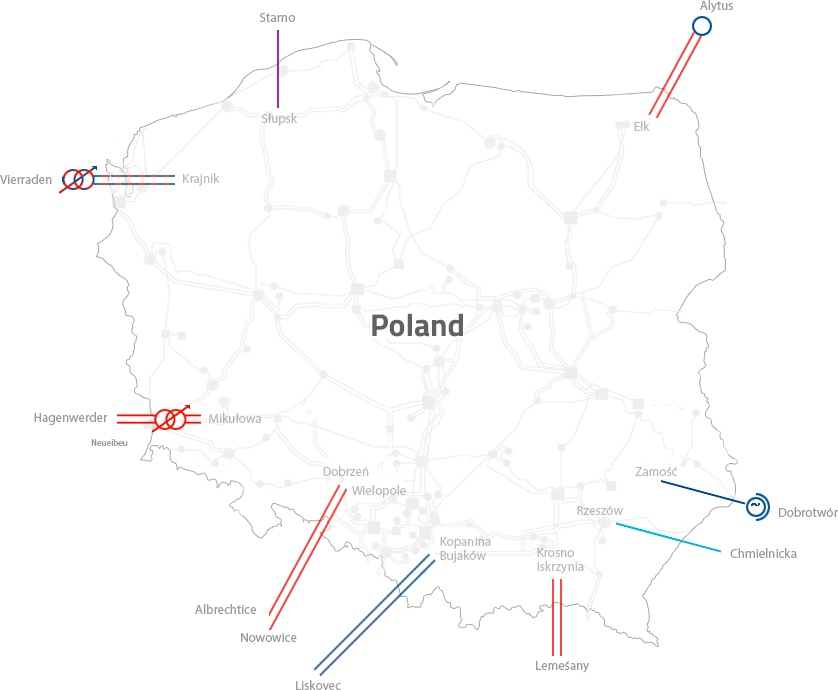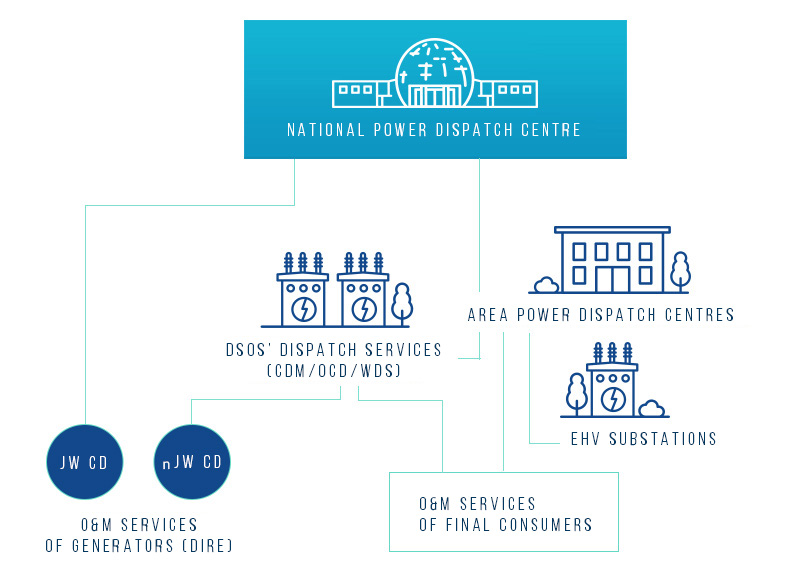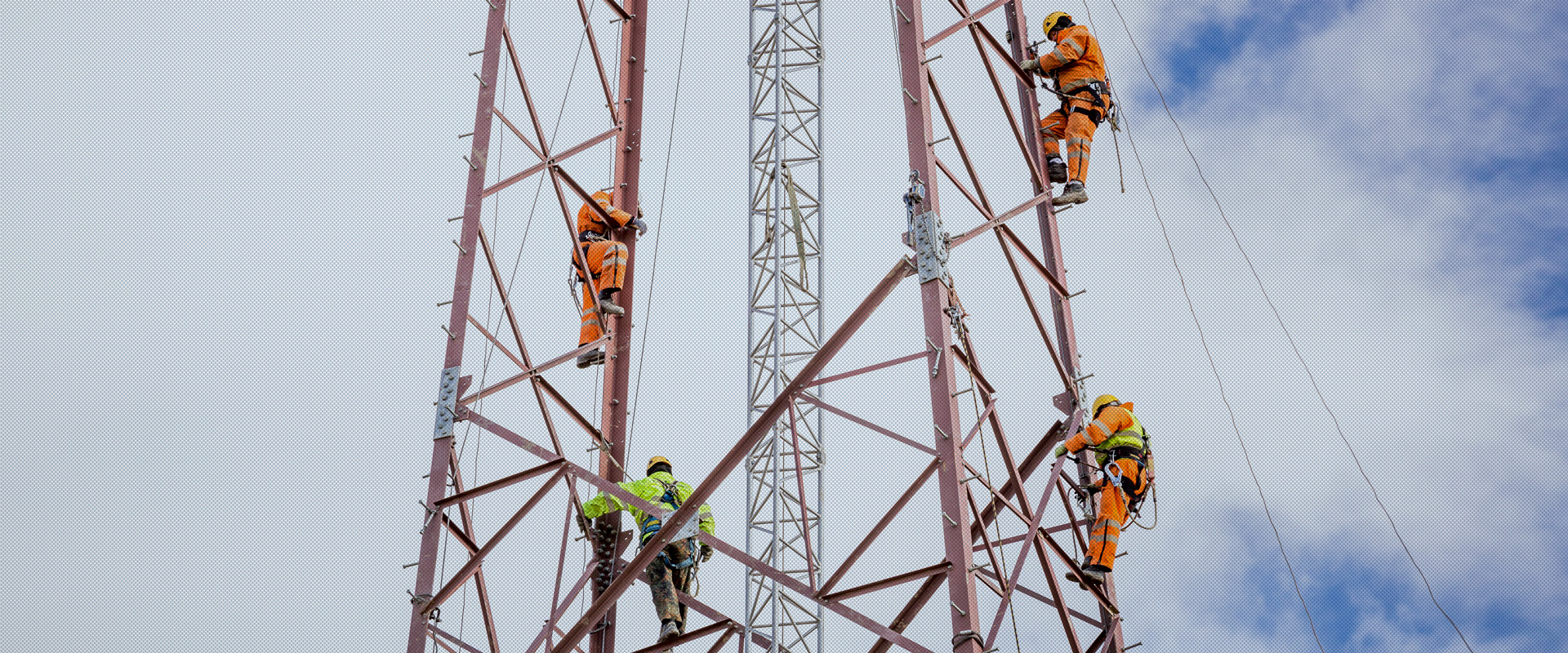Ensuring the operational security of the system significantly contributes to Poland’s economic growth, which is reflected in increased income and life qualify of Poles. Such impact of PSE on economic growth is possible owing to the company’s cooperation with numerous enterprises.
As a contributor of taxes and other levies, we have a positive impact on the local, regional and national budgets, enabling many significant projects to be financed.
- 46,799 MW
Installed capacity w the PPS in 2019
- 46,991 MW
Maximum capacity in the PPS in 2019.
- 26,504 MW
Maximum power demand in the PPS in 2019.
- 158,767 GWh
National gross electricity production in 2019, which represents a decrease of 3.9 percent compared with 2018.
- 169,391 GWh
National consumption of electricity in 2019, which represents a decrease of 0.9 percent compared with 2018.
- 141,297.33 GWh
Total electricity consumption by final consumers connected to the PPS.
- 97,228.13 GWh
Quantity of electricity supplied from the transmission network to domestic transmission service customers in 2019.
- 99.99 percent
Electricity supply continuity index in 2019. The level of this index confirms the certainty of power supply to all our transmission service customers.
- 601.26 MWh
ENS (Energy Not Supplied by the system).
- 111.50 minutes
AIT (Average Interruption Time in the system). Low levels of both ratios in 2019 testify to a high level of operational reliability of the transmission system and the certainty of supply to consumers connected to our network.
- 1.38 percent
Transmission loss rate. In 2019 it was the lowest ever.
- 99.77 percent
Availability index for transmission facilities (DYSU) in 2019. It reached a high value at reference value of ≥ 97.5 percent.
- PLN 1,5 bln
Capital expenditure in 2019.
- 164
Number of network infrastructure investment implemented in 2019.
- PLN 14 bn
Capital expenditure planned for 2021-2030
according to PRSP.

Management of the power system in Poland
GRI 103-1
- Electricity generation ─ electric energy production by generating sources in the power system – power plants, CHP plants and distributed sources.
- Electricity transmission ─ performed over the transmission network in order to deliver electric energy to distribution networks or transmission-connected consumers. Electricity transmission is performed by the transmission system operator whose functions are performed by PSE.
- Electricity distribution ─ delivery of electric energy over distribution networks to institutional and individual distribution-connected consumers. Electricity distribution is performed by distribution system operators.
- synchronously with the ENTSO-E Continental Europe countries (formerly UCTE),
- with dedicated generating units of the Dobrotvir power plant in the Ukrainian system,
- non-synchronously with the Swedish system via the DC submarine cable,
- non-synchronously with the Lithuanian system via the back-to-back DC link.
- Krajnik-Vierraden 400 kV double-circuit line – the line in an interim configuration (1 line circuit and 2 serially-connected phase shifters on the German side),
- Mikułowa-Hagenwerder double-circuit 400 kV line with a phase shifter in Mikułowa.
- Wielopole/Dobrzeń-Nosovice/Albrechtice double-circuit 400 kV line,
- Kopanina/Bujaków-Liskovec double-circuit 220 kV line.
- Krosno Iskrzynia-Lemesny double-circuit 400 kV line.
- DC Słupsk Wierzbięcino-Storno cable 450 kV line with a capacity of 600 MW.
- Double-circuit 400 kV line interconnected with the Lithuanian system via the back-to-back DC link with a capacity of 500 MW.
- Zamość-Dobrotvir single-circuit 220 kV line operating in coordination with dedicated generating units on the Ukrainian side (the interconnection allows only electricity import to Poland),
- Rzeszów-Chmielnicka single-circuit 750 kV line – shut down.

Sweden
Northern border (Poland-Sweden)
DC Słupsk Wierzbięcino-Storno cable 450 kV line with a capacity of 600 MW.
Germany
Western border (Poland-Germany)
Krajnik-Vierraden 400 kV double-circuit line – the line in an interim configuration (1 line circuit and 2 serially-connected phase shifters on the German side),
Mikułowa-Hagenwerder double-circuit 400 kV line with a phase shifter in Mikułowa.
Czech Republic
Southern border (Poland-Czech Republic)
Wielopole/Dobrzeń-Nosovice/Albrechtice double-circuit 400 kV line,
Kopanina/Bujaków-Liskovec double-circuit 220 kV line.
Slovakia
Southern border (Poland-Slovakia)
Krosno Iskrzynia-Lemesny double-circuit 400 kV line.
Ukraine
Eastern border (Poland-Ukraine)
Zamość-Dobrotvir single-circuit 220 kV line operating in coordination with dedicated generating units on the Ukrainian side (the interconnection allows only electricity import to Poland),
Rzeszów-Chmielnicka single-circuit 750 kV line – shut down.
Lithuania
Eastern border (Poland-Lithuania)
Double-circuit 400 kV line interconnected with the Lithuanian system via the back-to-back DC link with a capacity of 500 MW.
Russia
Russia
750kV
450 kV DC
400kV
220kV

Back-to-back DC tie

Phase shifter

Line being upgraded from 220 kV to 400 kV

Cross-border interconnection being upgraded

Radial line
- National Power Dispatch Centre (Krajowa Dyspozycja Mocy – KDM) – manages the operation of the 750, 400, 220 kV transmission network as well as selected 110 kV lines of system-wide significance.
- Area Power Dispatch Centre (Obszarowa Dyspozycja Mocy – ODM) – manages the operation of the 750, 400, 220 and 110 kV transmission network and switching operations.
- Central Power Dispatch Centres, Branch Power Dispatch Centres (CDM, OCD) – manage the operation of the 110 kV distribution network and switching operations in the 110 kV and lower-voltage distribution network.

GRI 103-2
- available capacity of generating units which are not centrally dispatched,
- additional capacity in power plants operating in overload, i.e. at a capacity higher than nominal (providing ancillary services),
- intervention power supply from pumped storage plants which allow power demand to be balanced (as part of ancillary services) within a short period (2-4 hours),
- dispatch electricity exchange with the neighbouring TSOs,
- cold intervention reserve,
- demand-side response (DRS) services.

- Regulation ancillary services (RAS):
- operating capacity reserve,
- share in primary control,
- share in secondary control,
- underload or overload operation,
- participation in automatic voltage and reactive power control.
- The Generating Unit activation service (hereinafter: “activation service”).
- Regulation ancillary services involving the intervention reserve:
- contingency operation,
- intervention cold reserve,
- demand-side response service.
- nJWCD reliability-must-run service (RMR service).
- Polish Power System restoration service.
Key system operation reliability indicators
GRI 103-3



continuity index (in %)
- Development of long- and short-term network operation coordination plans. Time schedules of both maintenance work and repair work on network elements and generating units in a manner that ensures the maintenance of surplus power levels required in a given period, available in excess of forecasted demand, as well as compliance with the required secure network operation criteria, including the reliability criterion (n-1).
- Development and implementation of a single maintenance model that allows the state of repair of equipment and its operational environment to be evaluated in a cyclic, standardised and measurable manner. Owing to those activities, the most depreciated and oldest grid assets – the potential source of emergency and fault conditions – are preventively replaced.
- Implementation of the maintenance personnel development programme. It supports the continuous competence improvement of the company's own maintenance personnel, including field personnel.
- Undertaking investment activities. Optimises the loading of transmission lines and eliminates overloads of transmission system elements.
- Systematic standardisation of network equipment and creation of storage facilities. Supports quick and cost-effective necessary replacements.
- Close cooperation and making arrangements with transmission service customers at each stage, i.e. from planning to execution.
GRI EU12

(e.g. illegal consumption of electricity)
- obtain an average exchange price (treated as a competitive market average) of electricity purchase to cover transmission losses,
- eliminate the risk of electricity purchase related to the purchase of a large volume of electricity in one or several moments in a year, e.g. through tendering procedures,
- rationalise the form of electricity purchase to cover transmission losses by switching from a one-off decision within an annual auction to:
- multiple purchase spread over time,
- the purchase of small volumes of electricity on the exchange market, according to strictly defined rules,
- improve the accuracy of the electivity volume planned to be purchased:
- performing long, medium and short-term forecasts,
- updating the electricity volumes planned to be purchased on the short-term market (e.g. a day ahead of real-time operation),
- reducing the volume of deviations in the Balancing Market,
- practically eliminate the possibility of the purchase electricity to cover transmission losses influencing the market price of electricity by purchasing very small one-off volumes of electricity while meeting very strict requirements in terms of pricing and liquidity of the exchange market.
